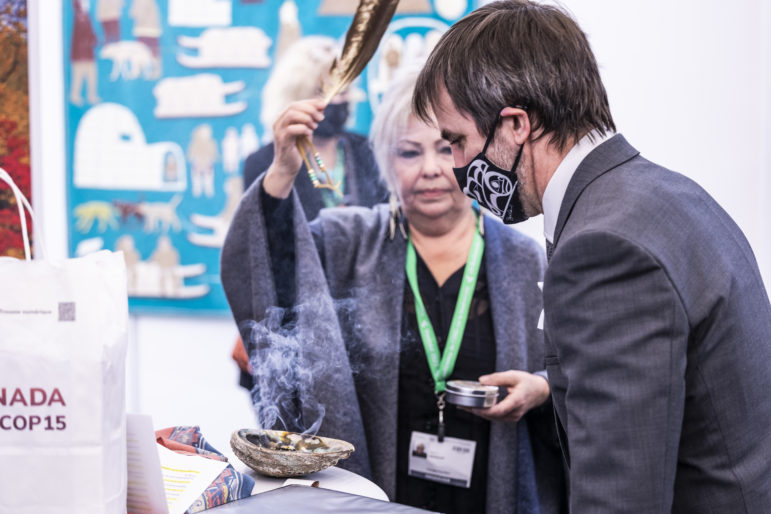TWH – The Conference of Parties 15 (COP 15) in Montreal, Canada took place from Dec. 7 to 19. This United Nations Conference focused on preserving global biodiversity. COP15 produced the Global Biodiversity Framework (GBF) with four goals and 23 targets to be reached by 2030.

Pavilion opening ceremony at COP15 2022 in Montreal – Image credit: UN Biodiversity – CC BY 2.0
The agreement
The United Nations Environmental Programme (UNEP) reported that COP15 had reached an agreement to preserve biodiversity through 2030.
The GBF has four general goals. Besides its four goals, the GBF has identified 23 measurable targets to achieve by 2030. When reached, those 23 targets will define the achievement of those four goals.
The first goal would require reducing the rate of extinction tenfold for all species by 2050.
The second goal would require countries to manage biodiversity. This management would ensure, recognize, maintain, and enhance nature’s contribution to humans. This goal specifically links environmental health to economic prosperity.
The third goal would require the equitable sharing of digital and genetic resources.
The fourth goal would ensure funding so that poorer countries could comply with the GBF.
On Dec. 19, the Convention on Biological Diversity (CBD) reported on COP15. It discussed the 23 measurable targets of the GBF.

Convention on Biological Diversity logo
Under one target, a country would have to legally protect large parts of its territory. Countries would have to legally protect 30% of their land area by 2030. They would also have to protect 30% of their inland, coastal, and marine waterways by 2030. At present, only 17% of land and 10% of marine areas are under protection.
Another measurable target would focus on cutting subsidies for materials that harm biodiversity. By 2030, it would phase out $500 billion per year in subsidies that harm biodiversity and require subsidies for materials that would benefit biodiversity.
Another goal involves raising funds from the developed world for the developing world to implement the GBF. The amount would be $20 billion USD per year by 2025 and increase to $30 billion USD per year by 2030.
The Nature Conservancy reported that the 1992 international agreement, “Convention on Biological Diversity” formed the basis for COP15. Since then, 196 countries have accepted or ratified that agreement. Unlike 196 other countries, the U.S. has failed to ratify the convention. Its failure to ratify the 1992 Convention prevented the U.S. from voting in COP15. The U.S. did send representatives to COP15.
Representatives from 188 governments took part in COP15. Two non-parties also participated the U.S. and the Vatican.
The absence of a formal role for the USA
On Oct. 14, 2021, Scientific American reported on the U.S. absence in efforts to preserve biodiversity. It also impacts the U.S. credibility in speaking about biodiversity and climate change. Both Russia and China have ratified the 1992 Convention.
The major problem lies in the U.S. Senate which has refused to ratify the 1992 Convention. Republicans led the opposition in the Senate. The 1992 Convention would require the U.S. to align its laws with global standards. As a result, GOP Senators have charged that the 1992 Convention threatens U.S. sovereignty. Parts of U.S. industry have also charged that the 1992 Convention threatens intellectual property rights.
Instead of binding legislative ratification, the U.S. has relied on temporary executive endorsements. The Biden Administration endorsed the protection of 30% of national lands and waters by 2030. This “30 by 30 goal” has similarities to those of the GBF.
The economics of biodiversity
Opponents of Green Politics have frequently argued that Green Politics threatens economic growth. Advocates of Green Politics have begun to challenge that opposition. The Global Assessment Report on Biodiversity and Ecosystem Services, from the Intergovernmental Platform on Biodiversity and Ecosystem Services (IPBES) reported that “An average of around 25 percent of species in assessed animal and plant groups are threatened.”

Image credit: Arek Socha from Pixabay
Around 1 million species already face extinction. Some species may become extinct within decades. UNEP described this as the largest loss of life since the dinosaur killing comet.
That report stressed human dependence on nature. Four billion people rely on natural medicines. Even 70% of drugs used to treat cancer are “natural or are synthetic products inspired by nature.” More than 75 percent of global food crops rely on animal pollination, which include coffee, cocoa, and almonds.
The World Economic Forum has rated biodiversity loss and ecosystem collapse as one of the top five risks in the next ten years. About half of the global Gross Domestic Product (GDP) depends on nature. The GDP consists of the sum of all goods and services produced. Construction ($4 trillion), agriculture (2.5 trillion), and food and beverages (1.4 trillion), all depend on nature.
Businesses and investors had a presence at COP15. On Dec. 21, Reuters reported that between 700 and 1,000 businesses attended COP15. Never before had a private sector presence been that visible at a UN biodiversity conference.
At least 330 companies had called for COP15 to strengthen and make mandatory Target 15. Under that target, companies would have to report their environmental impacts.
Eva Zabey, Executive Director of the corporate coalition, Business for Nature, said “Forward-looking businesses are asking you [to] be ambitious, they are asking for stronger regulation.” Zabey continued, “Their impacts, both positive and negative, need to be recognized, rewarded or penalized.”
The final agreement does include those changes to Target 15. It does not, however, include the word “mandatory.”
The companies Kering and L’Occitane announced a mobilization, the Climate Fund for Nature, from the luxury fashion and beauty sectors. They want to develop nature-based solutions. Geraldine Vallejo, sustainability program director at Kering, said the “projects will include reforestation, mangrove restoration, and protecting grassland from overgrazing.” She said that “beauty and fashion, use ingredients and resources from nature and from very fragile ecosystems.”
On Dec. 20, The Imperial College in London reported on their delegates’ view of COP15.
Dr. Caroline Howe of the Center for Environmental Policy noted that “for the first time, indigenous local knowledge … with respect to biodiversity and nature was awarded the attention it deserves.” On a more critical note, Howe said “many of the targets are vague and lack any measurable biodiversity indicators, which provides a potential loophole, allowing countries not to meet targets fast enough.” She also noted that “the funding mechanism to support communities and nations that will need to implement 30 x 30 is not yet sufficient.”
Dr. Pernille Holtedahl of the Centre for Climate Finance and Investment, noted nations have said they would contribute $30 billion annually to poorer nations. Holtedahl acknowledged that “the commitments are non-binding and we have already seen how global leaders can make impressive announcements, for example about finance to support climate change action, which are then not followed through.”
In four years, countries will return to monitor progress on reaching the four goals and 23 targets.
The Wild Hunt is not responsible for links to external content.
To join a conversation on this post:
Visit our The Wild Hunt subreddit! Point your favorite browser to https://www.reddit.com/r/The_Wild_Hunt_News/, then click “JOIN”. Make sure to click the bell, too, to be notified of new articles posted to our subreddit.